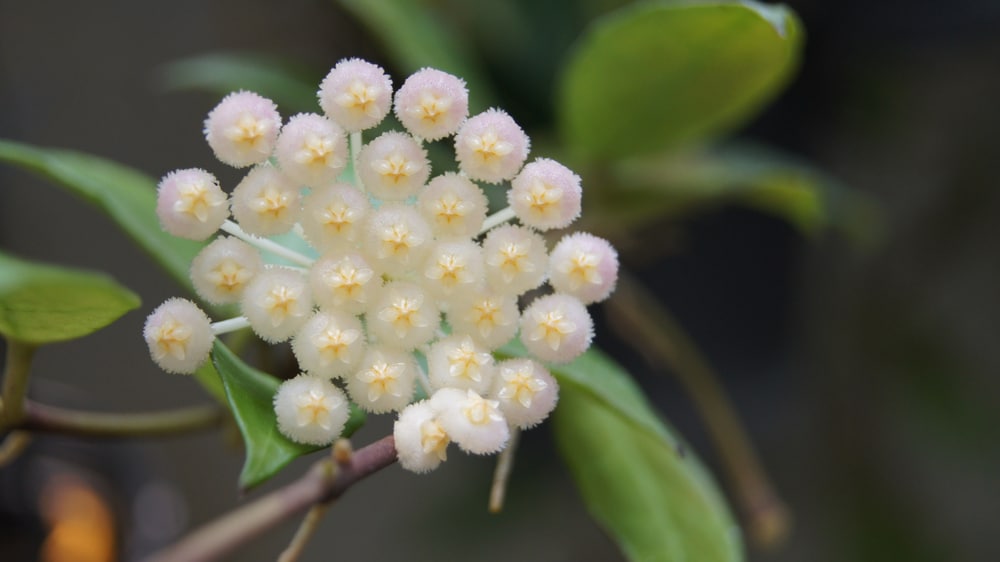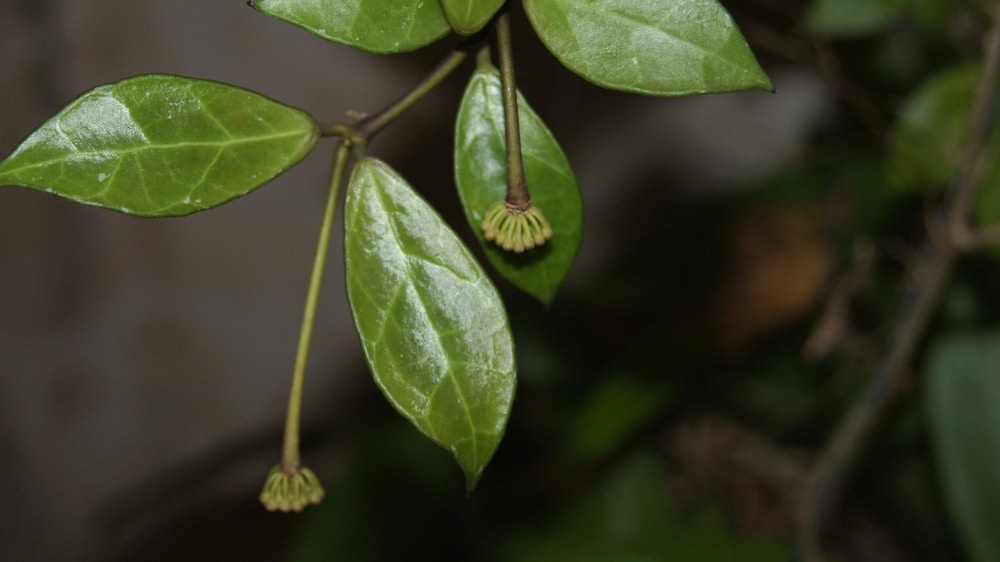Hoya Rebecca is a house plant in the dogbane family and is a crossbreed of Hoya lacunosa and Hoya obscura. Hoyas have an attractive wax-carved appearance and are aptly nicknamed the “wax plant.”
| Botanical Name | H. cv Rebecca |
| Common Name | Hoya Rebecca |
| Plant Type | Evergreen Perennial |
| Flower Color | Pink |
| Size When Mature | 40 – 80 Inches |
| Bloom Time | Late Spring to Summer |
| Sun Requirements | Partial Sun |
| USDA Hardiness Zones | 10 – 11 |
| Soil PH Range | 6.1 – 7.3 |
| Soil Type | Very Well-Drained |
| Water Needs | Low |
| Native Area | Southeast Asia, including China, Malaysia, India, Indonesia, Vietnam, The Philippines, and Australia |
What You Need to Know About Hoya Rebecca
The Hoya Rebecca is an attractive vine that will climb if given structure. The green, waxy leaves have a matte texture and red undersides. They are easy to grow and non-toxic to humans and pets.
In the spring and summer, Hoya Rebecca produces umbels of small bright pink flowers with yellow centers. The star-shaped flowers grow in clusters of anywhere between 10 to 25 flowers. Short hairs on their surface make them look fuzzy to the naked eye.
The flowers mature over two to three weeks and have a sweet fragrance. Some flowers might drip excess nectar. Their scent gets stronger in the evening to attract moths or butterflies that are active at night.
How To Care for Hoya Rebecca
Here’s everything you need to know about growing and caring for a thriving Hoya Rebecca.
Light
Hoyas need bright but indirect light to thrive. Hoyas planted outside will do best on a porch or any area where they can get plenty of indirect morning sun.
If kept indoors, Hoya Rebecca plants will do well in a window facing East. This allows them to soak in the sunlight before it gets too hot. During the winter, moving the plant to a location that gets more light might be necessary.
The foliage of Hoya plants is heat-sensitive and will turn yellow if exposed to direct sun and scorching heat. You can avoid this by keeping them away from the direct afternoon sun and rotating them often.
Water and Soil Needs
In the wild, Hoyas grow on trees. This fact means that they’ll need soil that is well-draining and coarse. A suitable soil recipe for growing healthy Hoyas is:
- One part of potting soil
- One part pumice
- One part of coconut husks
However, you can also use store-bought succulent mix. Soil like this should provide the right conditions for your Hoya to thrive.
Repot your Hoya Rebecca plant every other year to prevent hard soil clumps that might suffocate the roots. The ideal growing medium has a pH between 6.1 and 7.3.
These plants require thorough watering whenever the soil dries out. Soak the soil but don’t let the roots sit in water for too long. Ensure you drain all excess water from the soil to prevent root rot.
Temperature Requirements
As mentioned earlier, Hoya Rebecca can’t tolerate the scorching heat of direct sunlight. This plant will become stressed if exposed to temperatures over 95°F.
Hoya Rebecca is also intolerant to frost and can’t tolerate temperatures lower than 60°F for very long. If you live in an area with cold winters, you might want to invest in a plant heater to help your Hoya Rebecca thrive.
With such a narrow range of temperature requirements, Hoyas grow best in temperate areas. They can live outdoors in USDA zones 10 to 11 but also thrive indoors in any zone as long as they have enough light.
Fertilizer
Hoya Rebecca thrives on a balanced house plant fertilizer. Avoid fertilizing during its dormant period in the fall and winter months. Use a water-based fertilizer during the spring and summer about once a month.
If your plant’s leaves look pale, you can feed it every two weeks. But if the foliage looks dark and healthy, you can go as long as six weeks or more before feeding it again.
Common Diseases
Hoya Rebecca is susceptible to several pests, including spider mites, scale, and thrips. Mealybugs are also attracted to the leaves of this plant.
By checking your plants often, you can prevent pest infestations. Using neem oil or insecticidal soap regularly can also help prevent pests.
Hoya Rebecca Propagation
The best way to propagate Hoya Rebecca is with cuttings. A node should be present on the cutting for it to form roots. Hoya Rebecca cuttings will take root when placed in water, damp sphagnum moss, or soil. There are many other varieties of Hoya plants that can be propagated in the same way including hoya tricolor and hoya krimson queen.

